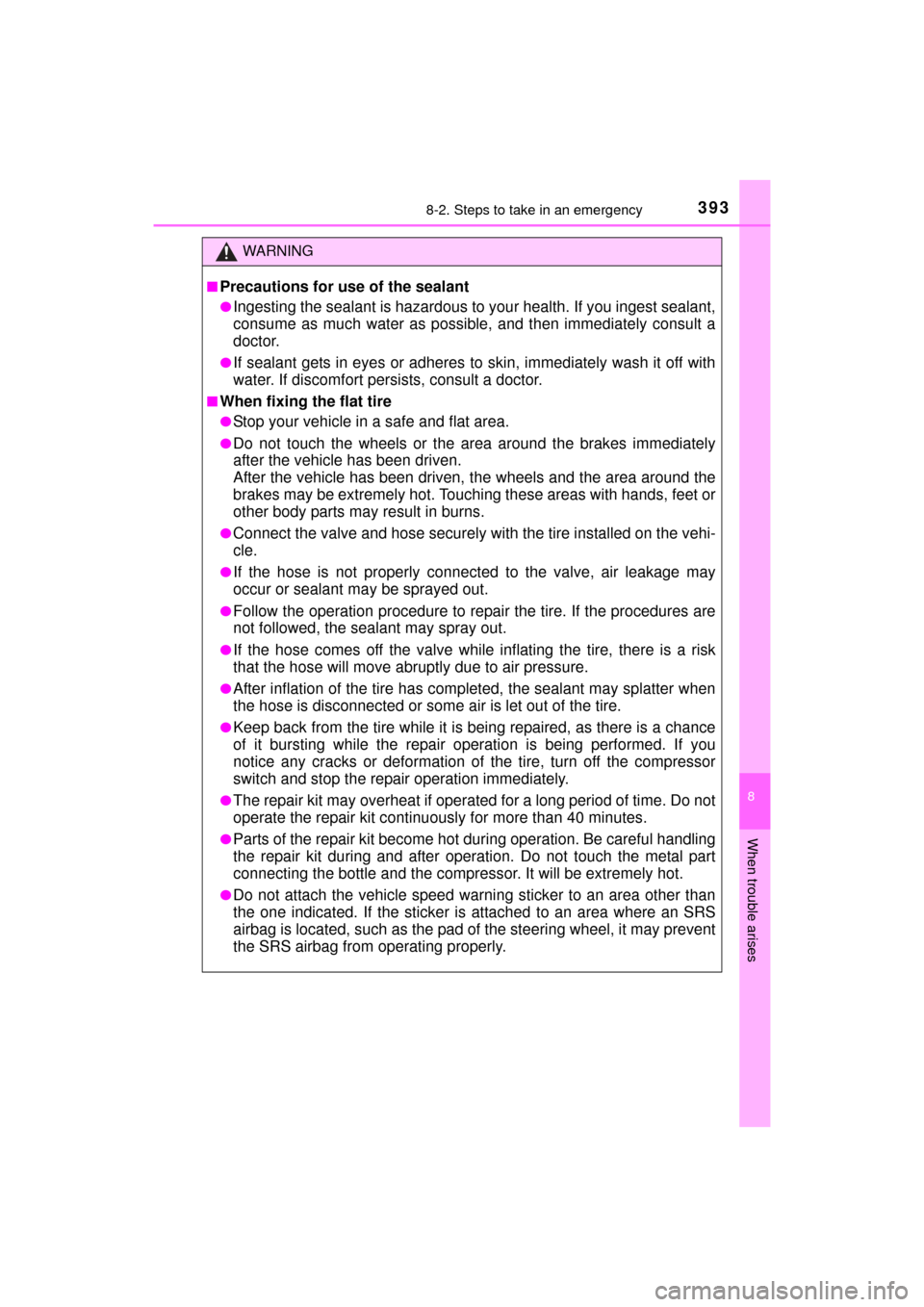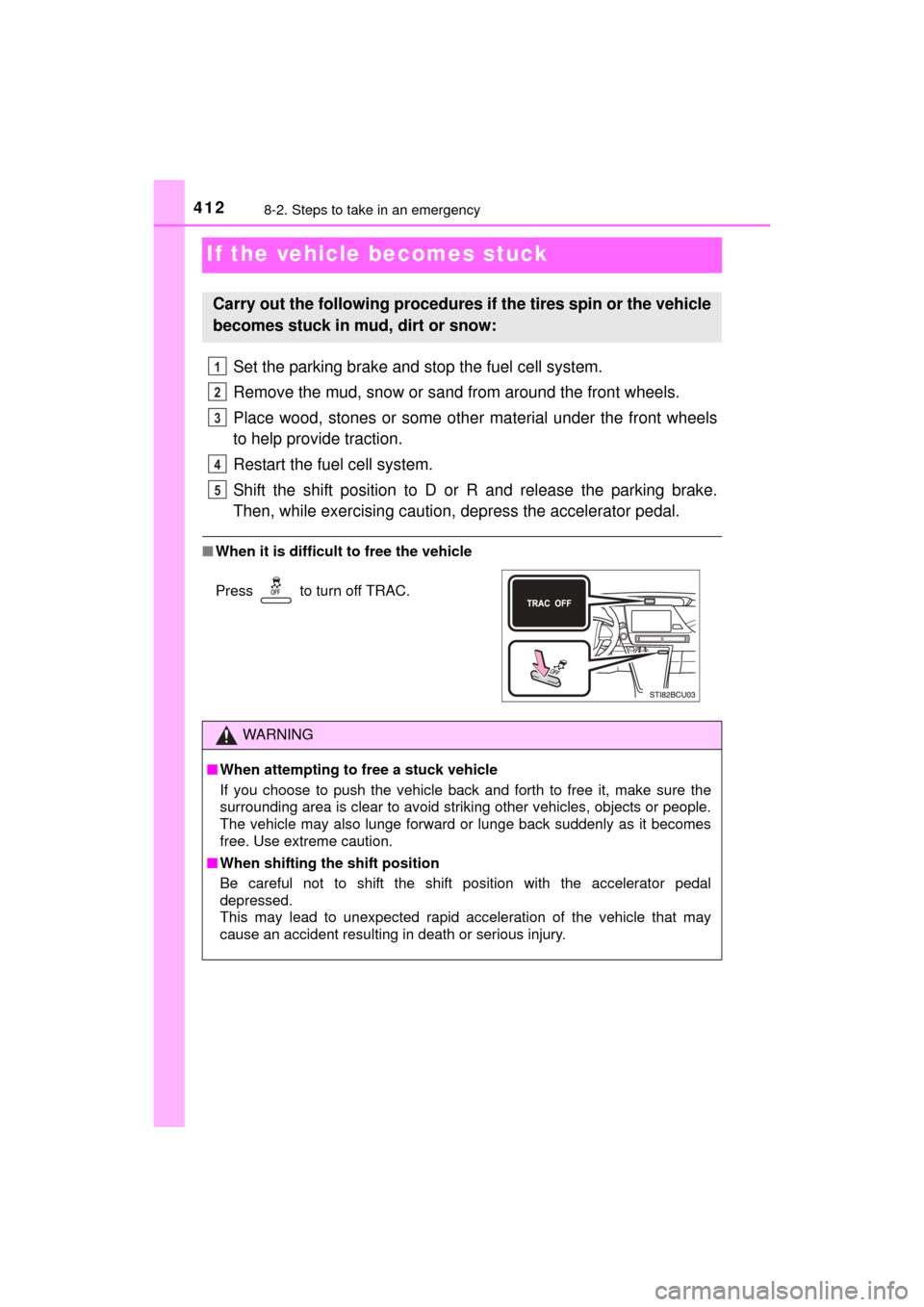Page 382 of 464
3828-2. Steps to take in an emergency
MIRAI_OM_USA_OM62004U
Location of the emergency tire puncture repair kit, tools and jack
Wheel nut wrench
Towing eyelet
Emergency tire puncture
repair kit
*: Use of the jack (P. 341)
Jack handle
Jack
*
1
2
3
4
5
Page 387 of 464
3878-2. Steps to take in an emergency
MIRAI_OM_USA_OM62004U
8
When trouble arises
Attach the 2 stickers as shown.
Remove any dirt and moisture
from the wheel before attaching
the sticker.
Check the specified tire inflation
pressure.
Tire inflation pressure is specified
on the label as shown. (P. 421)
Start the fuel cell system. ( P. 172)
To inject the sealant and inflate
the tire, turn the compressor
switch on.
9
10
11
12
Page 391 of 464

3918-2. Steps to take in an emergency
MIRAI_OM_USA_OM62004U
8
When trouble arises
■In the following cases, the tire cannot be repaired with the emer-
gency tire puncture repair kit. Contact your Toyota dealer.
●When the tire is damaged due to driving without sufficient air pressure
●When there are any cracks or damage at any location on the tire, such
as on the side wall, except the tread
●When the tire is visibly separated from the wheel
●When the cut or damage to the tread is 0.16 in. (4 mm) long or more
●When the wheel is damaged
●When two or more tires have been punctured
●When more than two sharp objects such as nails or screws have passed
through the tread on a single tire
●When the sealant has expired
■Emergency tire puncture repair kit
●The sealant stored in the emergency tire puncture repair kit can be used
only once to temporarily repair a single tire. If the sealant has been used
and needs to be replaced, purchase a new bottle at your Toyota dealer.
The compressor is reusable.
●The sealant can be used when the outside temperature is from -40 F
(-40 C) to 140 F (60 C).
●The repair kit is exclusively designed for size and type of tires originally
installed on your vehicle. Do not use it for tires that a different size than
the original ones, or for any other purposes.
●The sealant has a limited lifespan. The expiry date is shown on the bot-
tle. The sealant should be replaced before the expiry date. Purchase a
new bottle at your Toyota dealer for replacement.
●If the sealant gets on your clothes, it may stain.
●If the sealant adheres to a wheel or the surface of the vehicle body, the
stain may not be removable if it is not cleaned at once. Immediately wipe
away the sealant with a wet cloth.
●During operation of the repair kit, a loud operation noise is produced.
This does not indicate a malfunction.
●Do not use to check or to adjust the tire pressure.
Page 393 of 464

3938-2. Steps to take in an emergency
MIRAI_OM_USA_OM62004U
8
When trouble arises
WARNING
■Precautions for use of the sealant
●Ingesting the sealant is hazardous to your health. If you ingest sealant,
consume as much water as possible, and then immediately consult a
doctor.
●If sealant gets in eyes or adheres to skin, immediately wash it off with
water. If discomfort persists, consult a doctor.
■When fixing the flat tire
●Stop your vehicle in a safe and flat area.
●Do not touch the wheels or the ar ea around the brakes immediately
after the vehicle has been driven.
After the vehicle has been driven, the wheels and the area around the
brakes may be extremely hot. Touchi ng these areas with hands, feet or
other body parts may result in burns.
●Connect the valve and hose securely with the tire installed on the vehi-
cle.
●If the hose is not properly connec ted to the valve, air leakage may
occur or sealant ma y be sprayed out.
●Follow the operation procedure to repair the tire. If the procedures are
not followed, the sealant may spray out.
●If the hose comes off the valve while inflating the tire, there is a risk
that the hose will move abru ptly due to air pressure.
●After inflation of the tire has completed, the sealant may splatter when
the hose is disconnected or some air is let out of the tire.
●Keep back from the tire while it is being repaired, as there is a chance
of it bursting while the repair op eration is being performed. If you
notice any cracks or deformation of the tire, turn off the compressor
switch and stop the repair operation immediately.
●The repair kit may overheat if operated for a long period of time. Do not
operate the repair kit continuously for more than 40 minutes.
●Parts of the repair kit become hot during operation. Be careful handling
the repair kit during and after operation. Do not touch the metal part
connecting the bottle and the compressor. It will be extremely hot.
●Do not attach the vehicle speed warning sticker to an area other than
the one indicated. If the sticker is attached to an area where an SRS
airbag is located, such as the pad of the steering wheel, it may prevent
the SRS airbag from operating properly.
Page 394 of 464
3948-2. Steps to take in an emergency
MIRAI_OM_USA_OM62004U
WARNING
■Driving to spread the liquid sealant evenly
Observe the following precautions to reduce the risk of accidents.
Failure to do so may result in a loss of vehicle control and cause death
or serious injury.
●Drive the vehicle carefully at a low speed. Be especially careful when
turning and cornering.
●If the vehicle does not drive strai ght or you feel a pull through the
steering wheel, stop the vehicle and check the following:
• Tire condition. The tire may have separated from the wheel.
• Tire inflation pressure. If tire inflation pressure is 19 psi (130 kPa, 1.3 kgf/cm
2 or bar) or less, this may indicate severe tire damage.
Page 403 of 464

4038-2. Steps to take in an emergency
MIRAI_OM_USA_OM62004U
8
When trouble arises
Close the exclusive jump starting terminal cover, reinstall the motor
cover and the fuse box cover to its original position.
Once the fuel cell system starts, have the vehicle inspected at your
Toyota dealer as soon as possible.
■ Starting the fuel cell system when the 12-volt battery is discharged
The fuel cell system cannot be started by push-starting.
■ To prevent 12-volt battery discharge
●Turn off the headlights and the audio system while the fuel cell system is off.
● Turn off any unnecessary electrical components when the vehicle is running
at a low speed for an extended period, such as in heavy traffic.
■ Charging the 12-volt battery
The electricity stored in the 12-volt battery will discharge gradually even when
the vehicle is not in use, due to natural discharge and the draining effects of
certain electrical appliances. If the vehicle is left for a long time, the 12-volt
battery may discharge, and the fuel cell system may be unable to start. (The
12-volt battery recharges automatically while the fuel cell system is operat-
ing.)
■ When the 12-volt battery is removed or discharged
●In some cases, it may not be possible to unlock the doors using the smart
key system when the 12-volt battery is discharged. Use the wireless remote
control or the mechanical key to lock or unlock the doors.
● The fuel cell system may not start on the first attempt after the 12-volt bat-
tery has recharged but will start normally after the second attempt. This is
not a malfunction.
● The power switch mode is memorized by the vehicle. When the 12-volt bat-
tery is reconnected, the system will return to the mode it was in before the
12-volt battery was discharged. Before disconnecting the 12-volt battery,
turn the power switch off.
If you are unsure what mode the power switch was in before the 12-volt bat-
tery discharged, be especially careful when reconnecting the 12-volt battery.
● If the 12-volt battery is depleted with the shift position in P, it will not be pos-
sible to shift the shift position other than P. In this case, the vehicle cannot
be towed without lifting both front wheels because the front wheels are
locked by the parking lock. ( P. 363)
● When the 12-volt battery is reconnected, start the fuel cell system, depress
the brake pedal, and confirm that it is possible to shift into each shift posi-
tion.
● Make sure that the key is not inside the vehicle when recharging or replac-
ing the 12-volt battery. The key may be locked in the vehicle if the alarm is
activated. ( P. 75)
9
Page 412 of 464

4128-2. Steps to take in an emergency
MIRAI_OM_USA_OM62004U
If the vehicle becomes stuck
Set the parking brake and stop the fuel cell system.
Remove the mud, snow or sand from around the front wheels.
Place wood, stones or some other material under the front wheels
to help provide traction.
Restart the fuel cell system.
Shift the shift position to D or R and release the parking brake.
Then, while exercising caution, depress the accelerator pedal.
■ When it is difficult to free the vehicle
Carry out the following procedures if the tires spin or the vehicle
becomes stuck in mud, dirt or snow:
1
2
3
4
5
Press to turn off TRAC.
WARNING
■When attempting to free a stuck vehicle
If you choose to push the vehicle back and forth to free it, make sure the
surrounding area is clear to avoid striking other vehicles, objects or people.
The vehicle may also lunge forward or lunge back suddenly as it becomes
free. Use extreme caution.
■ When shifting the shift position
Be careful not to shift the shift position with the accelerator pedal
depressed.
This may lead to unexpected rapid acceleration of the vehicle that may
cause an accident resulting in death or serious injury.
Page 413 of 464
4138-2. Steps to take in an emergency
MIRAI_OM_USA_OM62004U
8
When trouble arises
NOTICE
■To avoid damaging the transm ission and other components
● Avoid spinning the front wheels and depressing the accelerator pedal
more than necessary.
● If the vehicle remains stuck even after these procedures are performed,
the vehicle may require towing to be freed.